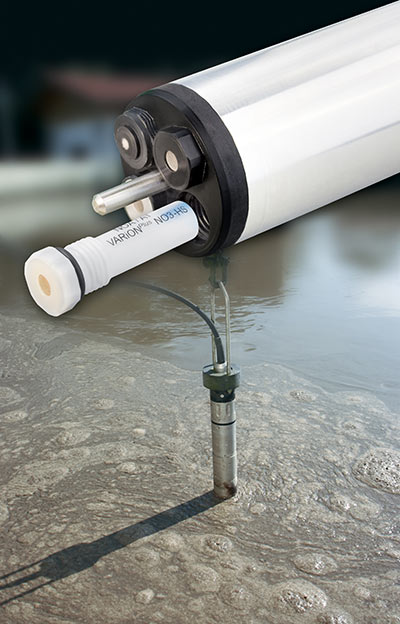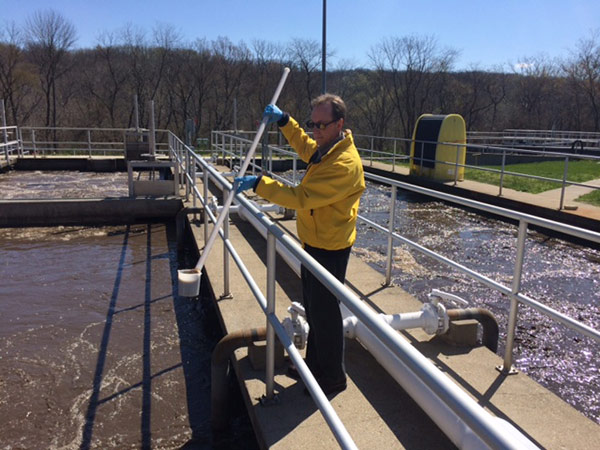Best Practices for Obtaining Reliable Online ISE Measurements
Water Resource Recovery Facilities (WRRF) across the US, and even around the globe, rely on their instrumentation for keeping their facilities in compliance and running at optimum levels. Processes that have historically been labor-intensive and time-consuming have, in recent years, become more and more automated with the technological advancements in the instrumentation available to plant operators.
One such advancement is the use of ion selective electrodes (ISE) as part of an online monitoring and control system. ISE’s are electrochemical sensors incorporated into probes that can be placed directly in the process, so they are ideal for continuous online operation.
A pH probe is one type of ISE that has been used as part of online process monitoring systems for decades, to provide a general indication of the progress of wastewater treatment. But capturing data for other parameters, such as ammonium and nitrate, have been relegated to laborious and offline methods of analysis, such as colorimetry used with grab samples.
It’s only recently, within the past ten years or so, that ISEs specifically for measuring other more specific parameters have become available for incorporation into an online process. The primary advantage of using ISE’s online is to obtain meaningful data about individual parameters, but with a much more economical technology that does not require replenishment of reagents.
Cost Savings
Having real-time and reliable data, monitoring specific substances like ammonia and nitrate, are critical for wastewater plant operators. Using an online system that ties the data directly into the facility SCADA to help control the process can be a real asset. As an example, WRRF’s typically address nitrification by turning on or turning up aerators in oxic zones, or address denitrification by adding chemicals to anoxic zones. Whatever adjustments need to be made, there is money spent on energy or chemicals, and it can add up to significant dollars over the course of a year. Using ISE’s as part of an online solution provides reliable real-time data, and can lead to substantial savings by fine-tuning and controlling the process. Reliable data can also help a wastewater plant stay in compliance, avoiding steep fines from regulating authorities.
Reliable Data Versus Accurate Data
Years ago, accurate measurement of ammonia and nitrate in the wastewater lab provided useful data for the facility. With current technological advancements, continuous measurement of ammonium and nitrate concentrations with online ISE’s is an important transition for facilities to make, to take advantage of process control opportunities.
It’s important to note that with process sensors, repeatability is the objective, not necessarily accuracy. Published accuracy specs for process sensors are not relevant once the sensor is out of the box. Accuracy is very dependent on the sample matrix, which varies with the application, so users should focus on obtaining reliable data with repeatable results.
Achieving Reliable Measurements with ISE’s
To ensure reliable measurements with online process ISE’s, it is important to take the necessary steps to set up and install the sensor correctly, and to provide proper and routine maintenance over the life of the instrument. This typically includes routine verification measurements which can be determined with a second, e.g. colorimetry in the lab. If the difference between the sensor and the lab measurement is greater than an acceptable tolerance, e.g. +/- 10% or +/- 0.2 mg N/L depending on the application, a matrix adjustment is required. The matrix adjustment is a typical procedure for correcting the ISE sensor calibration and is required as part of commissioning the measuring system and as necessary thereafter.
Matrix adjustment execution varies with the manufacturer, but the basic procedure consists of matching the online sensor measurement with a reference laboratory measurement on a grab sample as follows:
Step 1 - Clean the Electrodes – Electrodes in wastewater are especially prone to biological fouling. Routine manual cleaning is essential even with supplemental automatic air cleaning devices installed. The best cleaning agent is also the easiest to obtain – process water. Soaps, detergents, and even DI water can damage the membrane and shorten the life of the electrode. Scrub the electrode surface with a soft bristle brush (a toothbrush is perfect). The probe body can be cleaned with warm water and a brush.
Step 2 - Take Notes – Record the sensor values just prior to sampling for comparison to reference measurements. The recorded data should include both concentration in mg/L and the raw signal in mV. Some monitoring systems will store the value of the raw signal for each electrode and automatically match them to new reference concentrations determined in the lab. These values are entered manually or uploaded into the monitoring system.

Dr. Rob Smith using a sample dipper to collect a representative sample from the biological tank.
Step 3 - Sampling – Using a sample dipper, collect a sample as near to the position of the electrodes as possible. Rinse the dipper a couple of times before sampling to remove contamination from previous sampling events. Immediately filter the sample through a 0.45-micron filter into a clean, disposable sample vial to remove bacteria, which will quickly alter the composition of the sample. A delay of even 10 minutes can alter the composition of the sample and invalidate reference measurements, especially in warm water. Ammonia and nitrate are dissolved and will pass through the filter. Collect a filtered volume sufficient to allow measurement of each parameter with a suitable laboratory method. Generally, this will be less than 30 mL.
Step 4 - Measurement and Evaluation – Analyze filtered samples in the lab for ammonia and potassium (for compensation) and nitrate and chloride (for compensation) as necessary, using appropriate methods, e.g. colorimetry. It is tempting to skip verifying the compensation parameters. However, these measurements are very critical for the performance of the monitoring system. Evaluate duplicate or triplicate measurements as necessary to determine the most likely concentration.
Step 5 – Update and Check – Enter the new reference values and matching sensor values into the monitoring system. Compare the concentrations and values of raw signals from previous calibrations to evaluate the matrix adjustment and gain insight into the status of the electrodes. The concentration should vary proportionately with the signal. Changes in the wastewater matrix, errors in sampling and analysis, and aging and contamination of the electrode can cause the raw signal (mV) to drift independently from changes in the measured concentration. Some monitoring systems do the math automatically and record the information as part of the calibration history.
The frequency of matrix adjustments depends on the application, the design of the sensor, the age and history of the sensor, and the veracity of reference measurements. Typical intervals vary from weekly to every 3 months or longer.
Download: Best Practices for Wastewater Process Monitoring of Ammonium and Nitrate with Ion Selective Electrode (ISE) Sensors

Additional Blog Posts of Interest
Activated Sludge | Threes Steps to Improve Process Efficiency
Online Monitoring of Ammonium and Nitrate Helps Facility Meet Strict Discharge Limits
The Science of Phosphorus | Blog Series | 1 of 5
Water Reclamation Facility Meets Discharge Limits for Total Inorganic Nitrogen